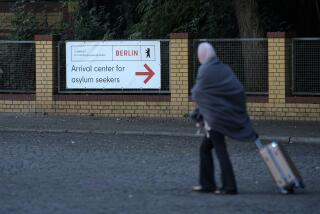Airport famed as site of Berlin airlift has a new role: refugee camp
reporting from berlin — It was a onetime Nazi showpiece, an indelible emblem of defiance during the Cold War’s Berlin airlift, and more recently, an unexpectedly beloved public space in this most postmodern of cities.
Now, the old airport at Tempelhof is about to find yet another incarnation: sheltering some among the massive surge of the migrants and refugees flooding into Germany. Berlin’s mayor, Michael Mueller, told the RBB broadcaster over the weekend that one of the airfield’s former hangars will be used to provide a roof – a lofty one at that - over the heads of about 800 asylum-seekers, as early as this week.
The need is great. Since the start of the current influx, the German capital has been receiving about 1,000 newcomers a day. More than 65,000 people have arrived in Germany this month, and the yearly tally may run to 1 million or more, officials now acknowledge. With winter fast approaching, housing is a crucial concern, with venues like a disused convention center and former military barracks being pressed into service.
FULL COVERAGE: Europe’s Migrant Crisis >>
The airport at Tempelhof was decommissioned in 2008 and eventually turned into a public park that sprawls over more than one square mile. Berliners – who flock to the vast open space on weekends to jog and bicycle on the former tarmac and send kites skittering aloft where aviation windsocks once flew - took the news of the latest repurposing in stride.
“Obviously, it’s a special situation,” said Johanna Otte, whose 5-year-old daughter squirmed in her lap as rollerbladers whizzed past. “If the space is there, we should utilize it, use it for the good.”
Tempelhof’s newfound place at the intersection of a humanitarian crisis and hipster entertainments has its jarring elements. This past weekend, the facility hosted a European franchise of the Lollapalooza music festival – even as planners were working to ready the hangar space for asylum-seekers, many of whom are disoriented and exhausted after an arduous journey.
To meet immediate housing needs, Mueller said a cavernous hangar would be heated and individual temporary accommodation and sanitation units set up inside, with busing available to bathing facilities at a nearby pool complex. A second hangar may be used as well to build longer-term housing blocs, the local Berliner Morgenpost newspaper reported.
NEWSLETTER: Get the day’s top headlines from Times Editor Davan Maharaj >>
Tempelhof, moments from the city center, mirrors nearly a century of Berlin’s tumultuous history. Built in the late 1920s, the airport was refurbished by the Nazis in the 1930s, with its immense, swooping terminal intended as a projection of both power and menace.
The airfield found worldwide fame during the Berlin airlift of 1948-49, when the city’s western sector was blockaded by Soviet troops during the inaugural days of the Cold War. Allied planes loaded with food and fuel touched down at Tempelhof every few minutes, providing a vital lifeline for the city’s cold and hungry.
The historic resonance of Tempelhof is not unique among housing sites being commandeered amid the spiraling refugee and migrant crisis. Asylum seekers are also sheltering in former barracks at Spandau, site of the notorious prison.
Berliners, though, are more accustomed than most to the collision of past and present.
“We should use whatever space is available to help these people,” said research psychologist Fabian Leuschmer, enjoying a family picnic at Tempelhof on an unseasonably sunny autumn day. “I’m not at all nervous. I’m sure Germany can handle this.”
Follow @LauraKingLAT on Twitter
MORE ON MIGRANT CRISIS:
European countries tighten borders, seek solutions to migrant crisis
Germany temporarily restricts flow of asylum seekers
Are terrorists posing as refugees to reach Europe? Probably not
More to Read
Sign up for Essential California
The most important California stories and recommendations in your inbox every morning.
You may occasionally receive promotional content from the Los Angeles Times.










